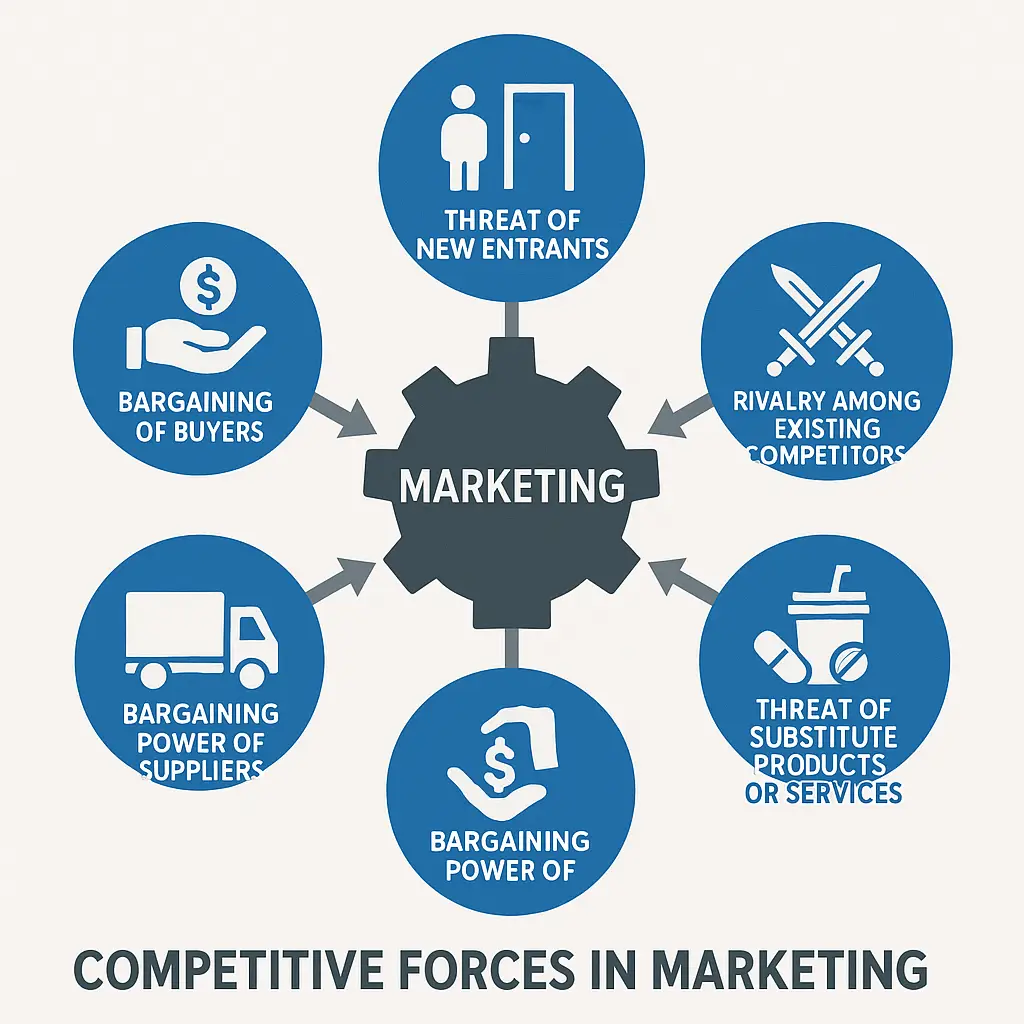Introduction
In the hyper-competitive marketplace of today, understanding the dynamics that shape industry competition is vital. Michael Porter’s Five Forces framework offers a structured way to evaluate your competitive environment and craft marketing strategies that capitalize on strengths while mitigating risks. This article dives into each force, explaining its relevance to marketing and providing actionable tactics to gain an edge.
1. Rivalry Among Existing Competitors
What It Is
Competitive rivalry refers to the intensity of battle between current players in your market. Factors such as the number of competitors, rate of industry growth, and product differentiation influence this rivalry.
Marketing Implications
- High rivalry often leads to price wars, aggressive promotions, and frequent product launches.
- Differentiation becomes key: brands must communicate unique value propositions to stand out.
Actionable Strategies
- Brand Storytelling: Craft compelling narratives around your heritage, mission, or social impact to create emotional bonds beyond price.
- Niche Positioning: Identify underserved segments and tailor your messaging to their specific needs (e.g., eco-friendly, ultra-premium, or budget-conscious).
- Loyalty Programs: Build retention by rewarding repeat purchases, referrals, and brand advocacy.
2. Threat of New Entrants
What It Is
This force gauges how easily new competitors can enter your industry. Barriers such as capital requirements, regulatory hurdles, and brand loyalty play a role.
Marketing Implications
- Low entry barriers mean you must continuously fortify customer relationships and brand equity.
- Marketing investments in awareness and preference help raise the “switching cost” for consumers.
Actionable Strategies
- Thought Leadership: Publish research reports, whitepapers, or webinars to position your brand as the go-to authority.
- Community Building: Foster brand communities (forums, social groups, live events) to deepen engagement and create peer-to-peer advocacy.
- Exclusive Partnerships: Secure co-marketing deals or exclusive product bundles that new entrants can’t easily replicate.
3. Threat of Substitute Products or Services
What It Is
Substitutes are alternative solutions that meet the same customer need but use different technologies or approaches.
Marketing Implications
- Even if direct competition is limited, substitutes can erode market share by offering convenience, lower price, or novel value.
Actionable Strategies
- Value Education: Create content that highlights the total cost of ownership, quality differences, or long-term benefits of your solution versus substitutes.
- Feature Innovation: Continuously enhance your product with features that substitutes lack—integrations, premium support, or personalization.
- Bundling & Ecosystems: Offer ecosystems of complementary products or services that make switching less attractive.
4. Bargaining Power of Buyers
What It Is
Buyer power refers to customers’ ability to demand lower prices, higher quality, or additional services.
Marketing Implications
- When buyers have many options or purchase in large volumes, they can pressure brands on price and terms.
Actionable Strategies
- Segmentation & Personalization: Use data to identify high-value vs. price-sensitive customers, then tailor offers and messaging accordingly.
- Tiered Offerings: Introduce multiple pricing tiers—basic, professional, enterprise—with clear benefit escalators.
- Experiential Marketing: Deliver memorable experiences (virtual events, VIP cohorts, behind-the-scenes tours) that strengthen perceived value beyond transactional benefits.
5. Bargaining Power of Suppliers
What It Is
Supplier power measures how much suppliers can influence your input costs, quality, or availability of materials.
Marketing Implications
- High supplier power can squeeze margins, forcing marketers to justify higher prices or absorb costs.
Actionable Strategies
- Vertical Integration Messaging: If you control production or sourcing, emphasize “direct-to-consumer” benefits—faster delivery, better quality, fair pricing.
- Supply-Chain Transparency: Share stories and data about ethical sourcing, sustainability certifications, or local production to add brand value.
- Diversified Sourcing Campaigns: Highlight multiple sourcing partnerships to reassure customers about stability and continuity.
Integrating the Five Forces into Your Marketing Plan
- Competitive Audit: Map your industry’s landscape, scoring each force on a scale (low, medium, high) to identify critical pressure points.
- SWOT Alignment: Translate Five Forces insights into your SWOT matrix—use strengths to counter high-threat areas and shore up weaknesses.
- Tactical Roadmap: For each force, select 1–2 marketing initiatives (from the actionable strategies above) and assign clear KPIs, budgets, and timelines.
- Monitor & Iterate: Set quarterly reviews to reassess force intensities—markets evolve, and so must your strategy.
Conclusion
Porter’s Five Forces offers a timeless lens to dissect industry competition and inform marketing strategy. By proactively addressing rivalry, new entrants, substitutes, buyer power, and supplier power, you’ll craft campaigns that resonate, defend against threats, and exploit opportunities.
Also read Porter’s Five Forces model

